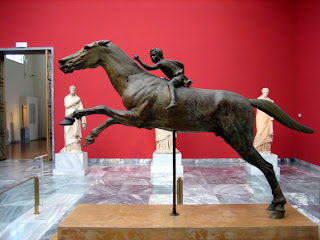ROMANTICISM ART
Romantic period was an artistic, literary, musical and intellectual movement that originated in Europe toward the end of the 18th century, and was at its peak in the approximate period from 1800 to 1850. With its emphasis on the imagination and emotion, Romanticism emerged as a response to the disillusionment with the Enlightenment values of reason and order in the aftermath of the French Revolution of 1789. In Romantic art, nature – with its uncontrollable power, unpredictability, and potential for cataclysmic extremes – offered an alternative to the ordered world of Enlightenment thought. The movement emphasized intense emotion as an authentic source of aesthetic experience, placing new emphasis on such emotions as apprehension, horror and terror, and awe – especially that experienced in confronting the new aesthetic categories of the sublimity and beauty of nature.
In 1808, Spanish painter Francisco Goya created images that were unambiguously anti-war. Rather than taking sides in these prints, Goya focused on how war brings out the basest human instincts. Later in 1814, Goya presented a more politically charged perspective. Created for a public audience, two paintings – The Second of May, 1808 and The Third of May, 1808 – commemorate events from the beginning of the war. The first image represents a bloody encounter that took place between the French army and the people of Madrid who rose up against them. The second depicts the execution of the rebels by the French on the following day.
The Second of May, 1808 (The Charge of the Mamelukes)
By Francisco Goya
1814 - 1815
The Third of May, 1808
By Francisco Goya
1814 - 1815
Specifically, the Third of May 1808 commemorates Spanish resistance to Napoleon's armies during the occupation of 1808 in the Peninsular War. With The Third of May, 1808, Goya has made an image of actual historical events, but enhanced them for maximum dramatic effect. The condemned men stand before a firing squad on the hill Príncipe Pío, one of several locations where such executions took place. The recognizable architecture of the city in the background lends immediacy to the scene. But it is the figures to the left of the composition that demand the viewer’s attention. The main figure, dressed in white, practically glows. Holding out his arms in an unmistakable reference to the crucified Christ, he appears as a heroic martyr. While the faceless French soldiers on the opposite side are rendered almost inhuman, the ill-fated Spanish rebels elicit both sympathy for their suffering and respect for their sacrifice.
Along with Picasso’s Guernica, Goya’s Third of May remains one of the most chilling images ever created of the atrocities of war. A powerful anti-war statement, Goya is not only criticizing the nations that wage war on one another, but is also admonishing us, the viewers, for being complicit in acts of violence, which occur not between abstract entities like “countries,” but between human beings standing a few feet away from one another.




Comments
Post a Comment